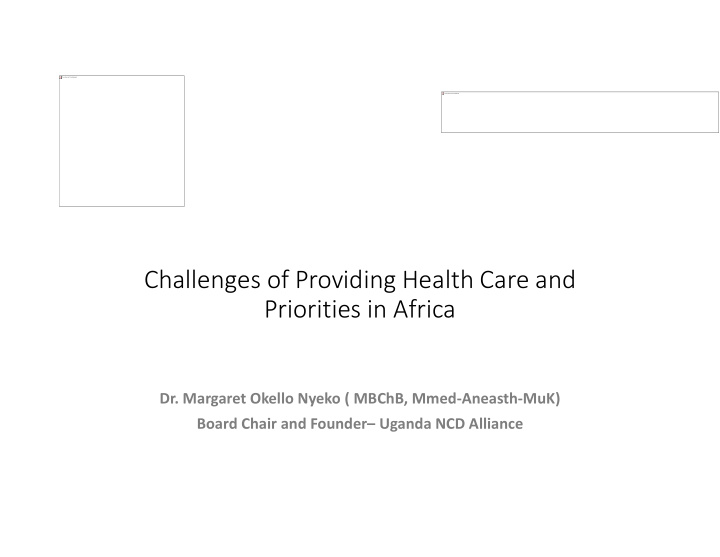



The picture can't be displayed. The picture can't be displayed. Challenges of Providing Health Care and Priorities in Africa Dr. Margaret Okello Nyeko ( MBChB, Mmed-Aneasth-MuK) Board Chair and Founder– Uganda NCD Alliance
Sub Saharan Africa The health service is characterized by: • Double burden of disease; more than 60% infectious diseases and Non communicable diseases are on the increase • Weak health care system • 25% of global disease burden, yet Africa has only 2% of the world’s doctors • Inadequate and poor health care infrastructure • Health system funding dependent on aid • Short term response to health needs-
The picture can't be displayed. Uganda’s situation • located in sub-Saharan Africa (SSA) within East Africa • Uganda is a low-income country (LIC) with GDP income per capita of US Dollars 604.04 (World Bank 2017) • Total population is 45.7 million, and population growth Rate- 3.4% with high immigration yet low emigration rates • Life expectancy at Birth-60years-Males /65year -females- • Total expenditure on Health per capita-$133
Challenges • Inadequate funding of health care for; prevention, disease management, medical equipment and manpower • High population growth rate leading to large disease burden, mainly Malaria, pneumonia, diarrhoea, anaemia etc • Less supervision of lower Health units • Inaccessible health facilities due to bad roads • Poor maintenance of buildings and equipment , replacement is difficult • inadequate staffing at all levels leading to too much workload and inefficiency in service delivery
Challenges cont • Refugee and internally displaced persons putting pressure on the limited health facilities • Poor sanitation all over Africa with only 58% of people living in sub saharan Africa have access to safe water • Health care is expensive and universal health coverage only achieved by a few countries • In Uganda, public facilities have drug shortages, few medical personnel and lack basic equipment for example: BP machines, glucometers and stethoscopes
The picture can't be displayed. Health Care system characterized by : Desperate patients wearing faces of poverty Long waiting hours
The picture can't be displayed. Large volume of patients Community members line up for health services Even with support from CSO-services remain inadequate
The picture can't be displayed. Inadequate infrastructure Infrastructure not good enough All ages all sex queue up together
The picture can't be displayed. The Ratio of health workers to Patients in Uganda • Doctor is 1:33,333, compared to WHO’s recommended 1:1,000 • Nurse is 1: 1,700 • Midwife is 1: 9,000 • Dentist is 1: 77,000 • Lab technician is 1: 16,000
The picture can't be displayed. Uganda’s Health system organization and service delivery In Uganda : • National health system and health delivery is by Public & Private sector • Private sector comprises of Private Not for profit (PNFP)& Private Health Practitioners(PHP), there are traditional herbalists • There is also Traditional Contemporary Medicine Practitioners. (TCMPs)-including herbalists. • Private sectors contributes about 47% of the health service delivery and 50% by public health sector
Priorities • Most of the countries in Africa still focus on traditional diseases like Malaria, HIV, diarrhoea and measles, yet with the changes in lifestyle and growing middle class, non communicable diseases are on the increase especially cardiovascular diseases, diabetes and cancer • Death due to Malaria and communicable diseases are reducing while those due to noncommunicable diseases are on the increase
Uganda’s health system in the face of NCDs • Double burden of communicable diseases and NCDs • Over the past 10 years, the prevalence of NCDs has overwhelmingly increased. NCDs among top 25 causes of Disability • Inadequate NCD funding • Poor access to essential medicines and technologies • Inadequate capacity of HRH • Weak surveillance systems • Overstretched by communicable diseases (malaria, HIV/AIDS, TB, measles & hepatitis) which are still the leading causes of morbidity and mortality • Weak integration for example using the HIV infrastructure to manage NCDs as both require chronic care model
The picture can't be displayed. Proportional mortality (% of total deaths, all ages, both sexes ) in Uganda
The picture can't be displayed. Progress of NCD Prevention and Control Efforts in Uganda • Draft Strategy on Prevention of Harmful use of Alcohol • Alcohol Control Bill • Tobacco Control Act • NCD Screening Guidelines • Draft Healthy Eating and Physical Activity Guidelines • UCI in the process of developing a national, population-based cancer registry • Cervical cancer prevention and control strategy
The picture can't be displayed. Suggested improvement • Train more young people as health workers of all cadres • Encourage public private partnership for a more sustainable funding • Encourage digital technologies for Africa ensuring eases access • More political commitment • Begin to focus more on NCDs by integrating NCDs care into existing health care service that has been largely oriented on infectious diseases.
THANK YOU
Recommend
More recommend